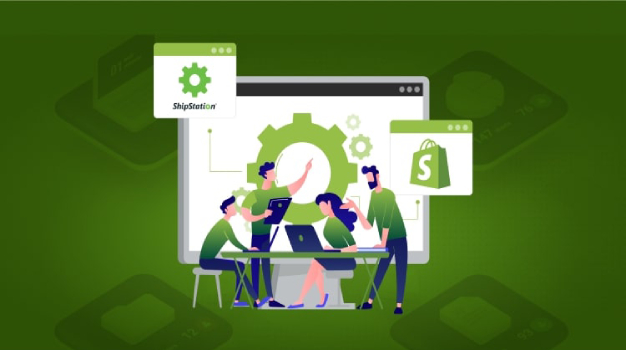Unlock Seamless Shipping: Using ShipStation to Navigate the e-commerce World
Table of Contents
What is ShipStation? What exactly does ShipStation do?
ShipStation is a web-based shipping platform that helps businesses manage small package shipping and e-commerce fulfillment. This allows you to pass on products and purchases directly to your customers. However, this is often not helpful when managing your inbound inventory when shipping at the freight level. Since it is a SaaS (Software-as-a-Service) solution, you do not need any special hardware or installation to use it.
You pay a monthly fee based on shipment volume and other factors.
In the United States, ShipStation is a growing tool that many small businesses are using to expand their operations. So we’ll take a quick look, discuss whether it might be right for you, and address any customer concerns.
What are the main features of ShipStation?
ShipStation is designed to work with your business and existing e-commerce software to make it easier for you to manage and ship orders. Therefore, the service has five main areas of features and tools designed to make these actions easier and better for a business:
Order management
ShipStation claims to integrate with more than 70 sales channels to help businesses manage omnichannel orders. You have a single dashboard to view and customize, and you can trust ShipStation to create a unified picture of your business. The tool can be configured to automate a variety of general and specific actions for different channels based on inventory thresholds and order details.
A nice feature here is the ability to split orders across multiple warehouses so you can fulfill them faster.
Transmitting
When you receive an order and are ready to ship it, ShipStation will help you navigate that process. Access multiple carriers and rates, choose shipping discounts, and print labels for you. Shipping documents are automatically generated and attached to the order in your system. The software associates each order with a customer’s details in case you need to get in touch with them.
ShipStation includes order verification, so your team must scan items as they are added to orders, then picked and packaged. This can enhance customer service and help you maintain accuracy. Red Stag Fulfillment uses multiple analysis and verification tools to ensure our guaranteed high accuracy rate.
Branding
Branding is an important way for ecommerce brands to stand out. ShipStation and similar services typically offer specific branding elements to help you create a unique look. ShipStation’s goal is to create your company’s tracking pages and returns portals so your logo is always available. Additionally, you can use it to print your details and logo on packing slips and shipping labels, as well as to send branded emails to customers.
Inventory management
Many ecommerce platforms are designed to help you manage your inventory by reducing the number of tools you need to use every day. ShipStation is no exception, offering a computer and smartphone platform to help you track your inventory. Tools include the ability to view your stock levels, reserve stock for specific orders, and set inventory alerts so you receive notification before your stock runs out.
You can train ShipStation on your warehouse layout so that pick orders and packing slips include storage locations, making it easier for employees to move around the warehouse in an orderly manner and speeding up delivery. levy.
The Integration
A prerequisite for e-commerce tools – and any tools you use to run your business – should be the ability to integrate and collaborate with multiple partners or programs. ShipStation includes some of the biggest names in e-commerce in the United States, so you’ll likely be able to continue using your favorite systems. Integrations include marketplaces, seller locations, shopping cart tools, stores, vendors, and many third-party theme plugins or services.
What is the advantage of using ShipStation?
Shipping isn’t a rocket science, and when a product like ShipStation first came out in 2011, it didn’t exactly seem like a brilliant solution to business problems. Originally intended as a way for eBay sellers to save time and perhaps act a little more like a real business, the launch of ShipStation didn’t exactly get much of a response: “Geez, what will they think next? » eBay sellers, though. , were delighted with the service. The almost immediate demand for such a service led founders John Hodges and Byron Wier to quickly expand their offering to all online sales. The response was overwhelming: it all started in October 2011; as of August 2012, ShipStation was generating approximately 1.3 million shipping labels per month.
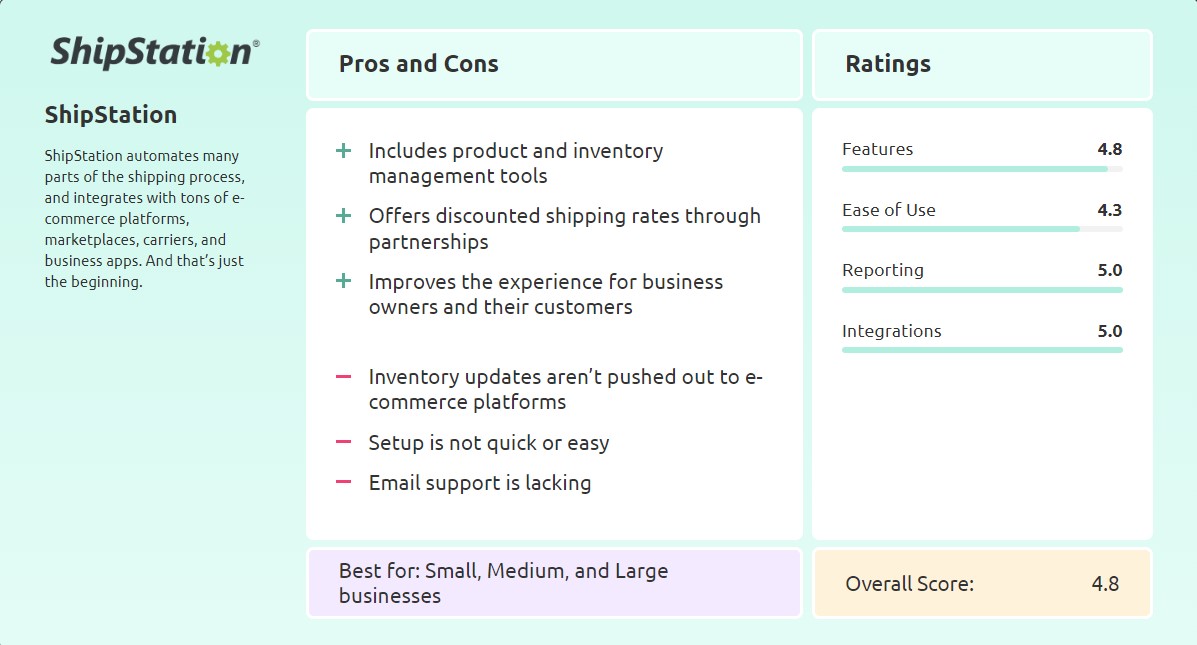
At launch, ShipStation only supported shipping through the U.S. Postal Service through a partnership with Endicia, the company that developed postal barcode printing technology. ShipStation’s meteoric rise had a huge impact on Stamps.com’s business. So that Stamps.com purchased ShipStation in 2013 and replaced Endicia in the USPS shipping software.
Today, ShipStation works with all major carriers, dozens of e-commerce platforms, and integrates with other business software tools. And with a list of features beyond just creating labels, the software generally makes life easier for its customers.
Details
The real magic happens in the background and in all the different ways you can automate certain processes. In fact, no automation can take place without knowing a large number of variables in advance. To this end, ShipStation also functions as a fairly competent inventory management system. It maintains a database of all your products and each product can be configured with a surprising number of options. Dimensions and weight are obvious factors in determining the best shipping method, but ShipStation can also accommodate more demanding storage needs. For example, if you sell the same product in multiple stores and they require different SKUs (this could be for several reasons), the software can create product aliases so that different SKUs correspond to the same product. There is also support for item variations (e.g. clothing in different sizes or items that can be sold individually or in bulk).
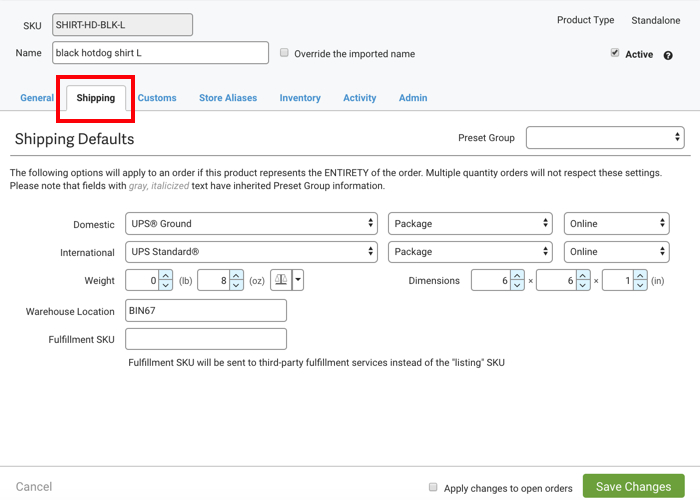
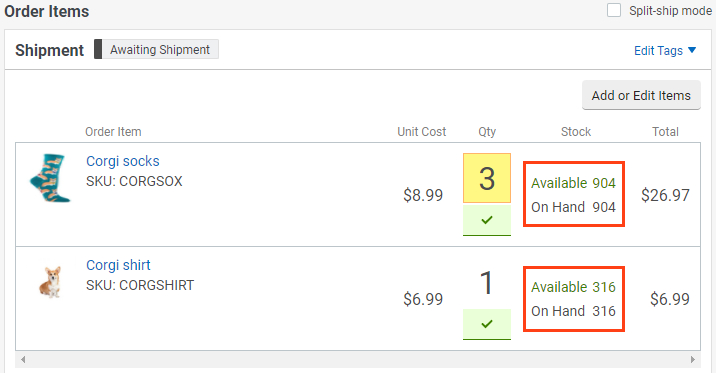
Still, there’s so much to love about Shipstation that it’s worth tackling this problem alone. You can create predefined items to automate certain aspects of shipping preparation. For single item orders, you can configure all shipping settings in advance. Someone orders a t-shirt and ShipStation automatically pre-populates all the shipping parameters (weight, package dimensions, and preferred service). So all you need to do is create the label when you’re ready to ship. Presets can also be created in groups, so you don’t need to create one for each t-shirt you sell: just create them once and add all the t-shirts to the group. There are a number of automations you can set up, and if you do it right, all you have to do is confirm that all your pending shipments look good, then package your products and apply the labels.
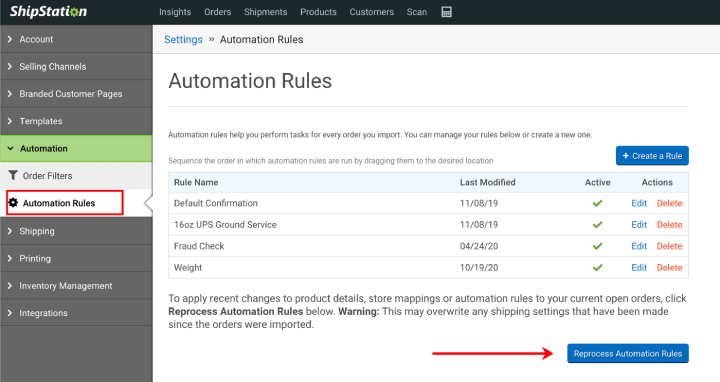
Conclusion
Who really thinks about shipping when starting an online business? Or more precisely: who takes into account all the details related to shipping? We’d all like to think we know what that means, but unless we’ve never done mail order before, we really don’t. It’s not as simple as it seems: it’s not just a matter of putting the products in a box, paying the shipping costs and shipping them. If you choose to manage everything manually, you’ll understand how much there is still to think about it. When it comes to fulfilling the orders you receive through your ecommerce site. And as you realize it might be as simple as you originally planned, you may be wondering what options you have to streamline your operations. Or you would have if you hadn’t already read this review.
FAQ
Is ShipStation easy to use?
This question is subjective and may change based on your experience, but ShipStation reviews are generally positive. Users love simplifying multiple aspects of order processing and facilitating communication with their partners and customers. The dashboard is simple but effective.
How much does ShipStation cost?
ShipStation currently offers 6 predefined pricing options, but you will need to contact the service if you ship more than 10,000 shipments per month. Please note that if you exceed your shipping volume at any time, your shipping plan will automatically be upgraded to the next tier.
Is there an app for Shipstation?
Many of your interactions with ShipStation will occur on desktop computers, as the platform is generally easier to manage on a larger screen. However, the service includes a comprehensive app that allows you to quickly view inventory, manage orders, make deliveries and communicate with customers.

